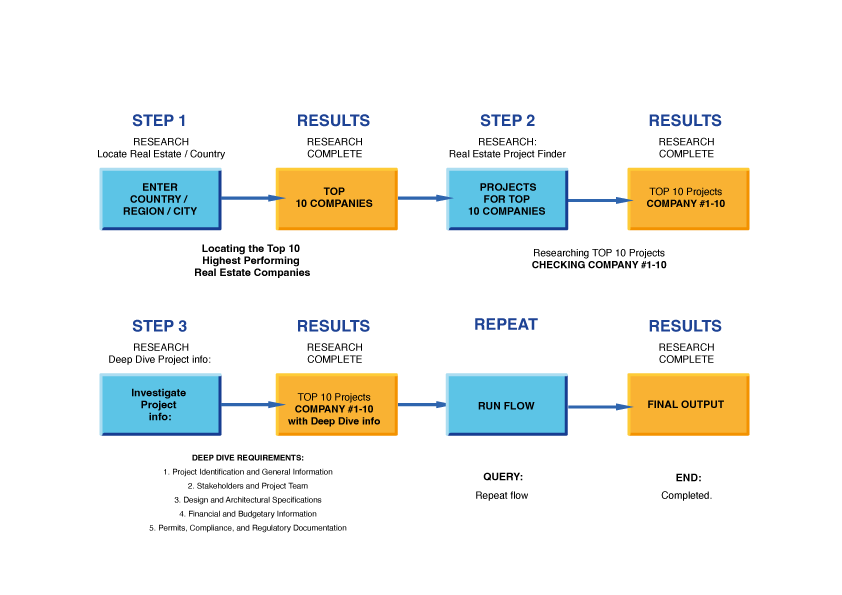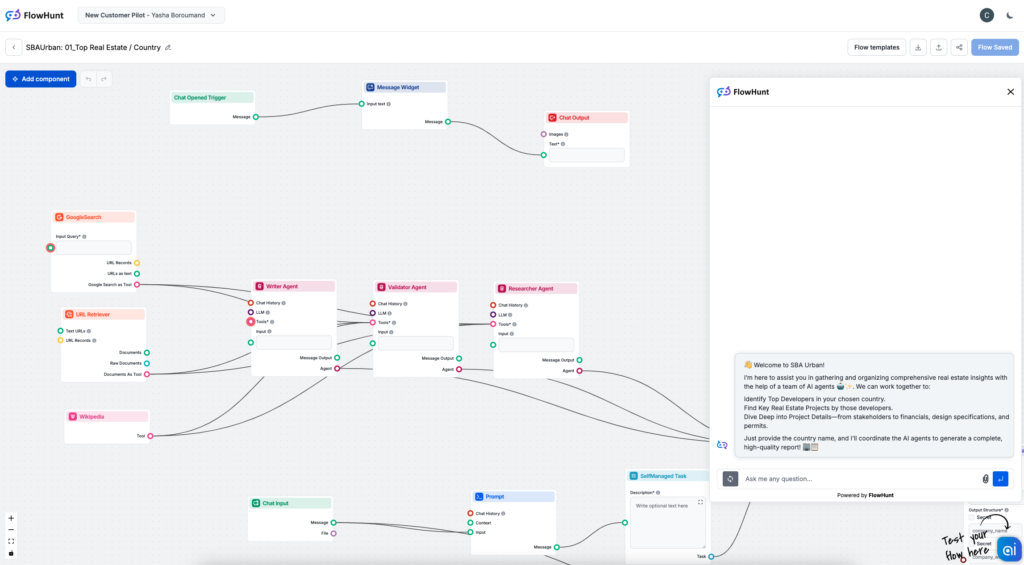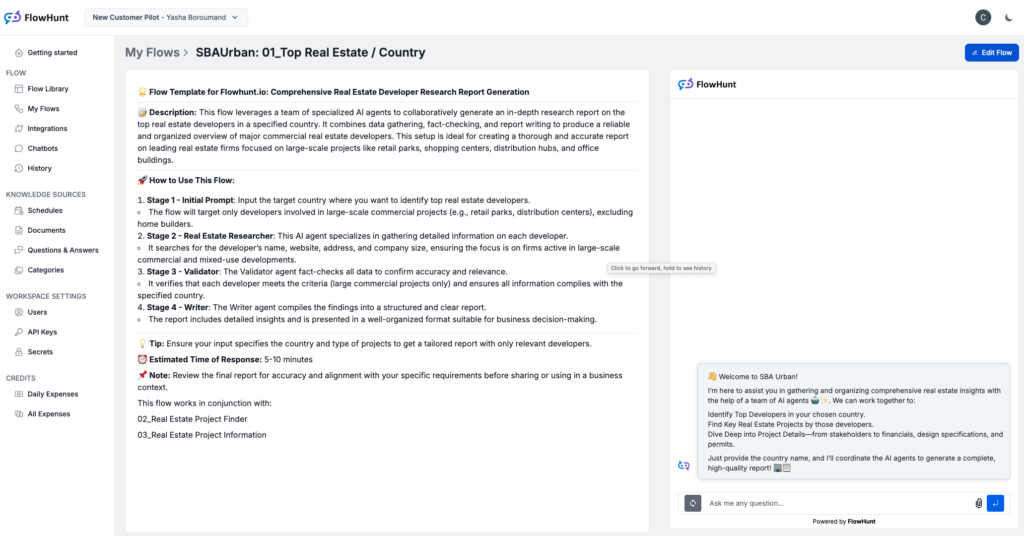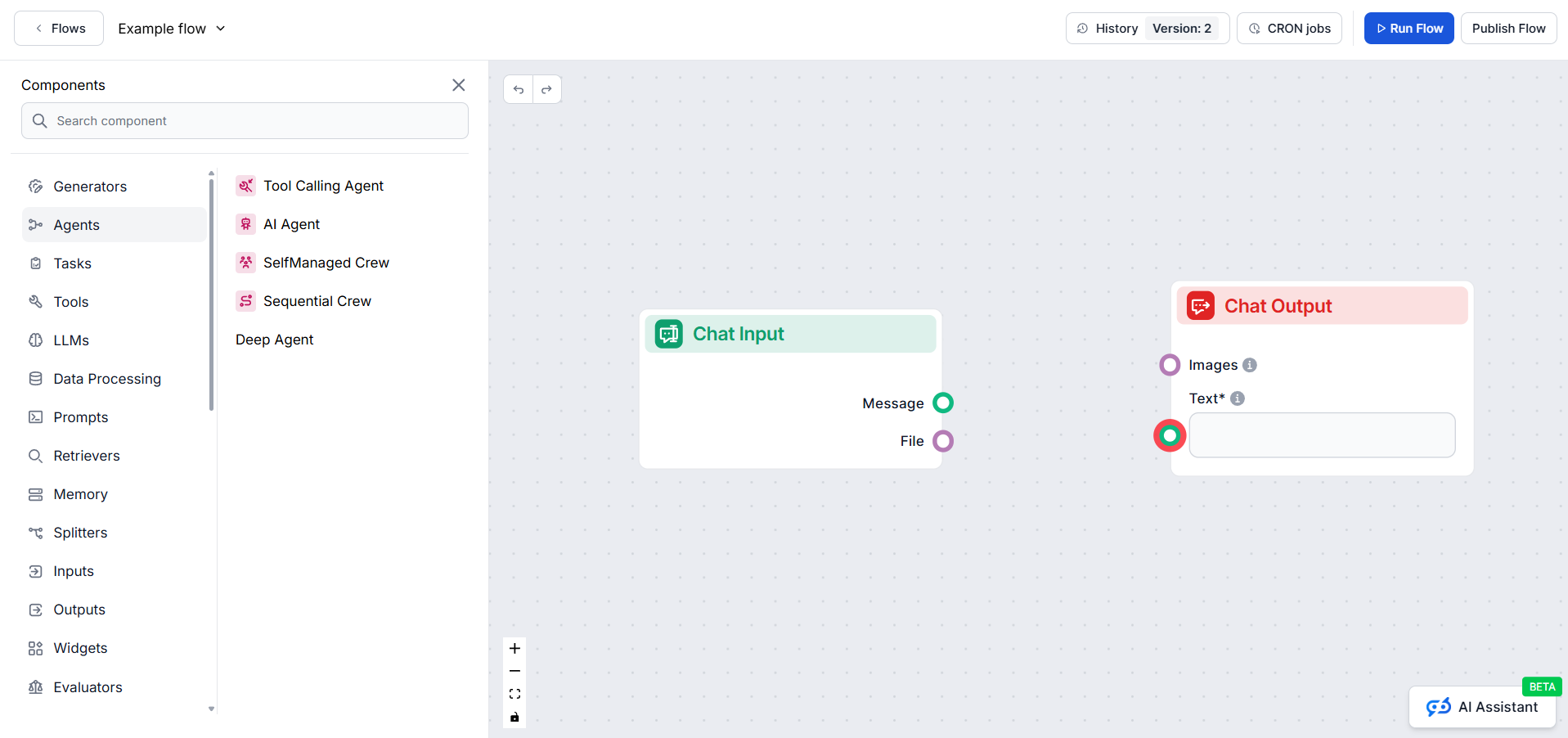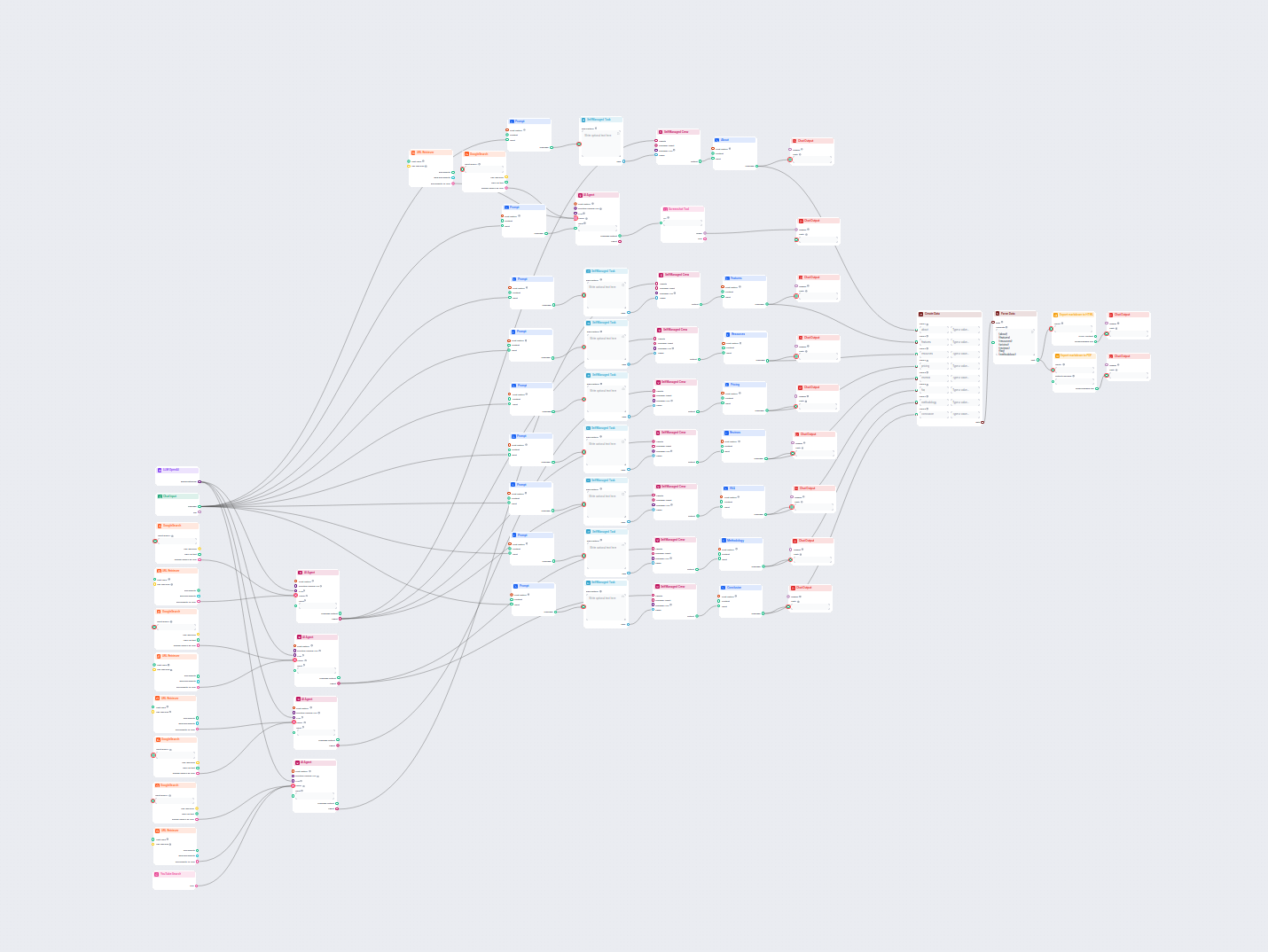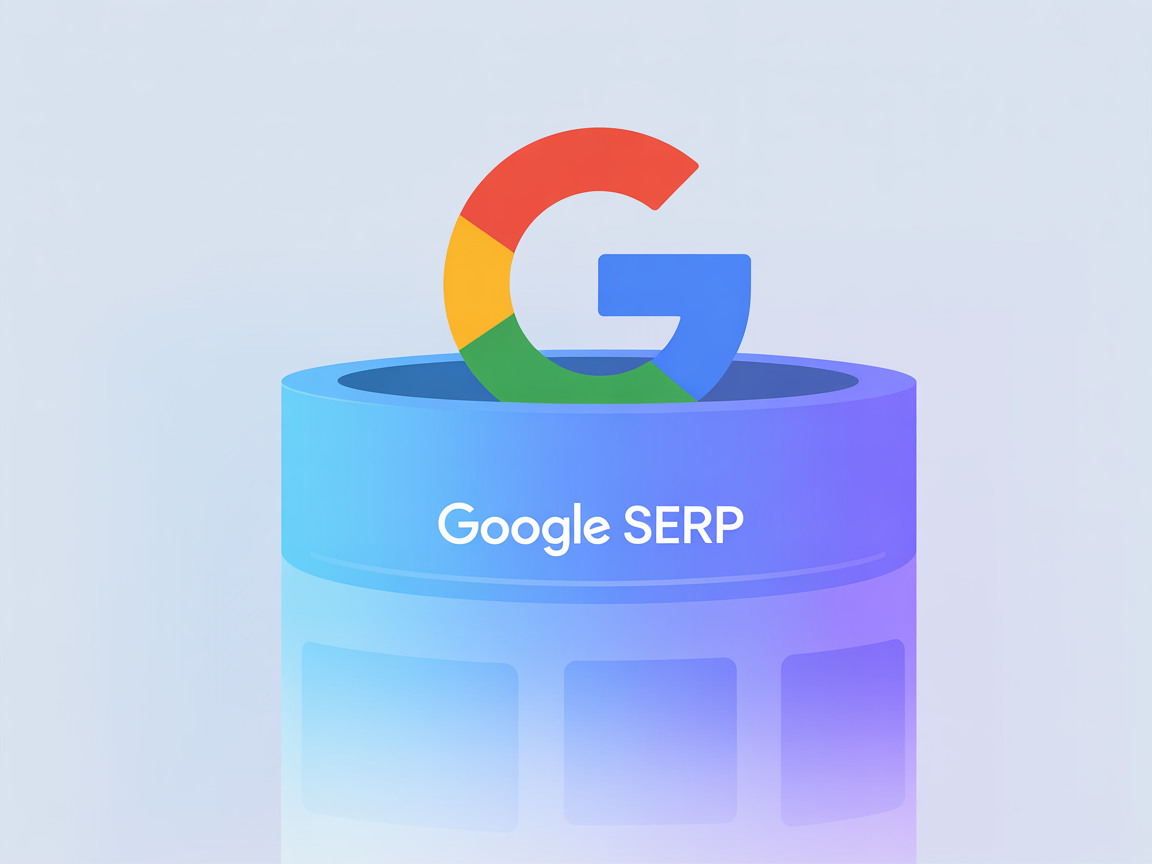
Advanced Google SERP Analysis
Discover the Advanced Google SERP Analysis Flow by FlowHunt—a strategic tool for deep insights into search engine results pages. Optimize your content strategy,...

Learn how AI-powered workflows transform competitor analysis in real estate, delivering actionable insights, automating research, and optimizing resource use.
When competition is fierce, as it is in real estate, strategic insight into the leading competitors and full data can make the greatest difference. Any real estate developer, investor, or consultant depends upon efficient workflows that ease the process of competitor analysis and project evaluation. Therefore, this article breaks down the flow of the AI-powered workflow designed to analyze leading real estate developers and their projects, focusing on the steps and agents involved, and the value that such a course brings with it.
This involves a multi-step AI workflow in capturing, validating, and structuring information on the best-performing real estate companies and their flagship projects from a given country. Each step in the process is designed to gather specific data points, analyze them, and present relevant insights suitable for decision-making in the realm of real estate. Here are the key stages of the workflow created in FlowHunt.
First of all, an investigation to determine the top 10 performing real estate companies in a selected country is put into operation. Here is how it works:
Enter Country Name – This first input narrows down the entire analysis. For example, if one were to enter “United Kingdom” as the target country, then the AI system would narrow down its research to target companies actively developing large commercial projects in that country.
AI draws from experience in leading real estate companies currently engaged in large commercial projects such as retail parks, shopping centers, office buildings, and mixed-use developments. This process filters out purely residential or small developers and narrows the selection down to only major market players.
Key Data Points:
This stage identifies verified information about each of the listed developers by utilizing a URL retriever and some of the functionality of Google’s search functions.
When the list of the top 10 real estate companies has been compiled, the next step takes one to delve deeper and find out the key projects of those companies, giving a detailed overview of each company’s key projects.
Project Finder Tool: This AI feature retrieves information about the top 10 projects for each real estate company. For example, if “Company A” is one of the major developers in the country that is being focused on, the AI will run deep analysis to provide information on 10 of its best projects.
Key Data Collected:
Each one of these pieces of information would typically be subject to some sort of validation process for accuracy and applicability, especially compliance-related information and regulatory data.
This working process applies the utilization of special AI agents to lighten the work at each step. Thus, here is a breakdown into their respective functions and objectives:
These agents cooperate through AI-powered tools like Sequential Crew, Self-Managed Crew, and utilities of Google search with the ambition of a well-oiled system working independently.
For every detected project, the workflow does a piece-by-piece analysis concerning various aspects, including:
All of these sections are populated by domain-specific AI agents that know source materials relevant to this information and present this knowledge. They use hyperlinks to trustworthy sources to ensure verifiability and traceability.
This AI-driven workflow could be extended at various levels of geography and would, therefore, be ideal for those organizations operating at an international scale. The scaling structure could comprise the country level with about 200 countries worldwide, the regional levels comprising an estimated average of 20 regions per country, the city level with about 20 cities per region, and local areas within the cities, in case the city is one of the major urban centers—averaging 10 sub-areas per city.
This exponential structure makes it possible for hundreds of thousands, if not millions, of data points to be embraced in the workflow for a comprehensive competitive analysis of companies with global interests in real estate.
The proposed AI-driven competitor analysis promises value for money regarding its precision, scalability, and automation. Targeting large-scale, commercially impactful projects and leading developers of real estate, this workflow provides:
Employee Savings:
Automates repetitive tasks, freeing employees to focus on higher-value work and reducing labour costs.
Enhanced Productivity:
Streamlines operations and integrates with existing tools, boosting efficiency and reducing time spent on projects.
Error Reduction:
Minimizes human errors, saving on potential rework and compliance costs.
IT and Development Savings:
No-code setup avoids costly custom development, making implementation quick and affordable.
Resource Optimization:
Ensures teams operate at peak efficiency, reducing operational costs by up to 30%.
In other words, this structured AI workflow saves the much-needed hours and resources. They also equip real estate professionals with the profound insights to make informed, competitive decisions within an evolving market.
Competitor analysis in real estate involves researching and evaluating leading developers and their key projects to gain strategic insights, benchmark performance, and inform investment or development decisions.
AI automates data collection, validation, and reporting, reducing manual effort, increasing accuracy, and enabling real-time insights into competitors' activities and projects.
Key data points include developer names, websites, company sizes, top projects, stakeholders, architectural details, financials, compliance documents, and more.
Yes, the workflow is designed to scale from country-wide to city and sub-area levels, making it suitable for organizations with global real estate interests.
FlowHunt’s AI-powered workflows save time, reduce errors, cut costs, and deliver deep, actionable insights for better strategic decision-making in real estate.
Transform your real estate research with FlowHunt's no-code AI workflows. Automate data gathering, gain strategic insights, and streamline your project evaluation process.
Discover the Advanced Google SERP Analysis Flow by FlowHunt—a strategic tool for deep insights into search engine results pages. Optimize your content strategy,...
The Flow editor allows you to drag and drop components representing various AI abilities. No coding skills are required, ensuring a visual and intuitive buildin...
Generate comprehensive, SEO-optimized product review articles for software tools, including detailed features, pricing, user reviews, resources, and more, with ...
Cookie Consent
We use cookies to enhance your browsing experience and analyze our traffic. See our privacy policy.
